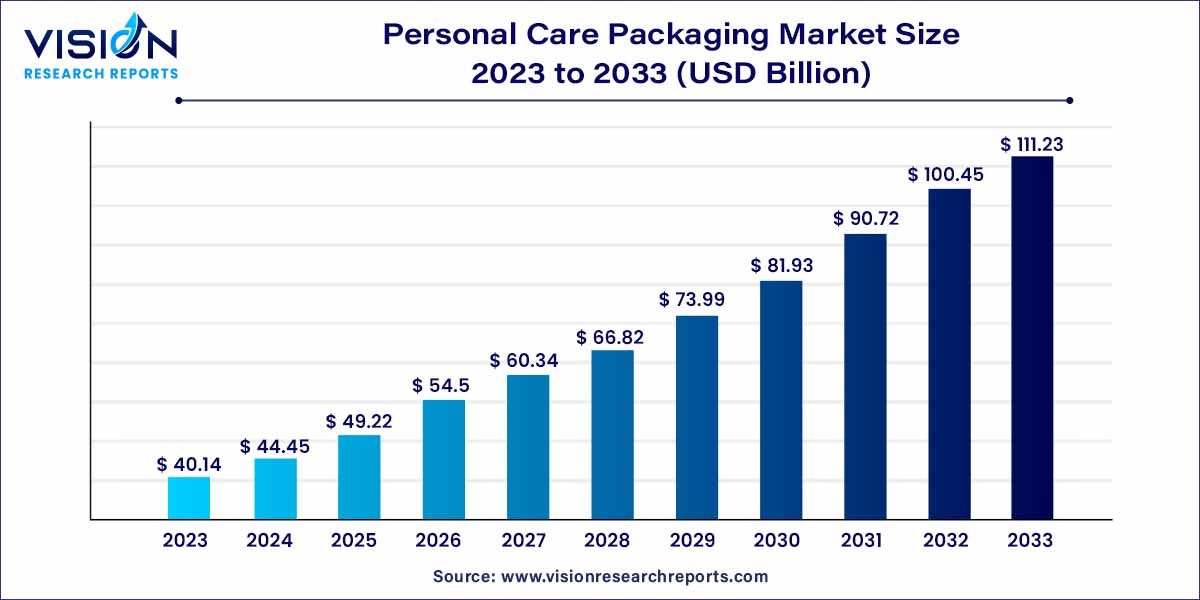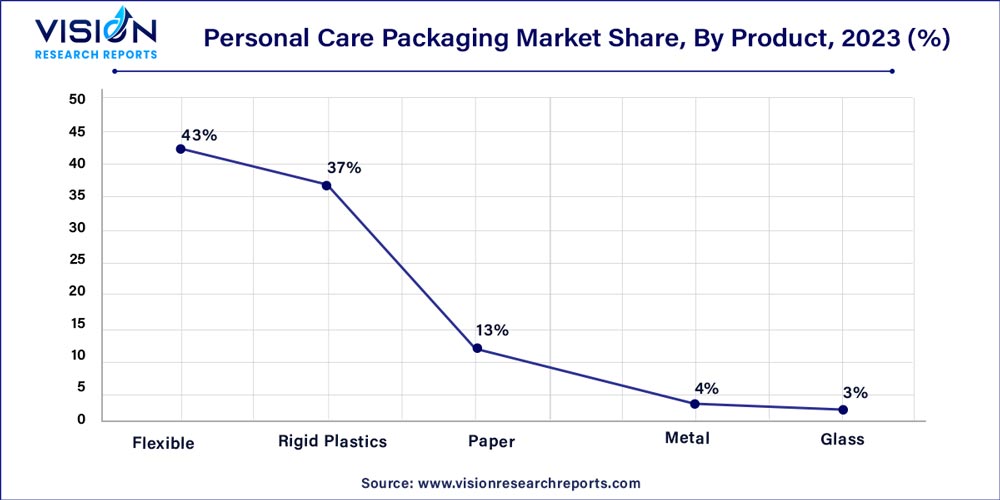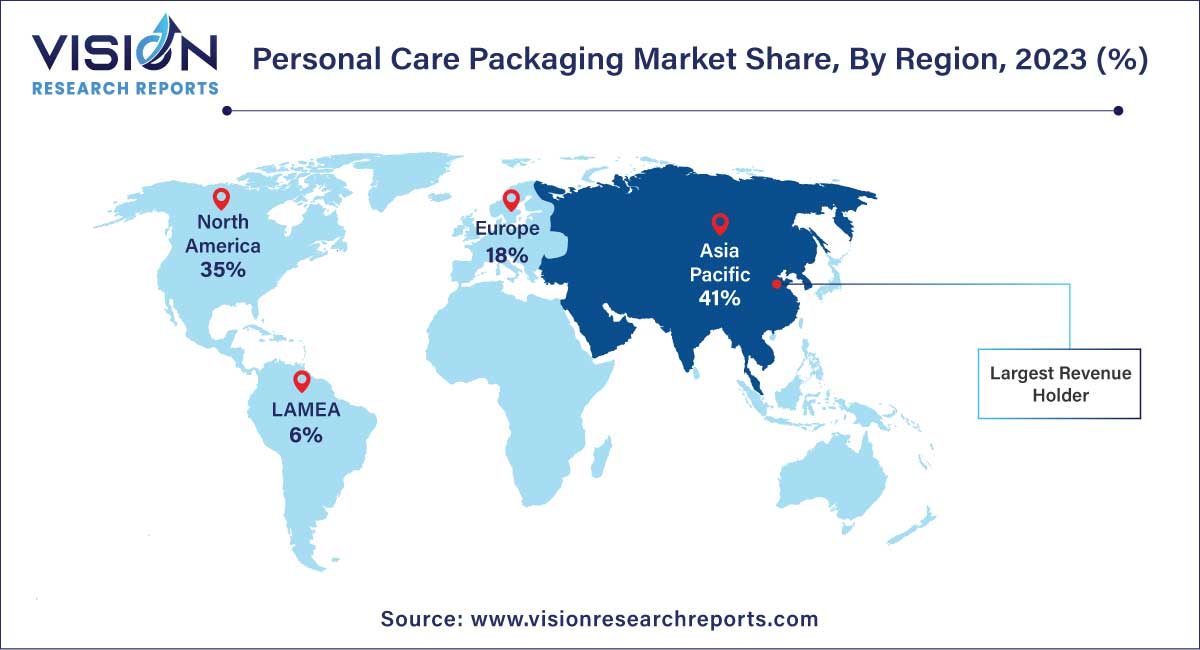The global personal care packaging market was valued at USD 40.14 billion in 2023 and it is predicted to surpass around USD 111.23 billion by 2033 with a CAGR of 10.73% from 2024 to 2033.

The personal care packaging market plays a pivotal role in the beauty and personal care industry, contributing to both functionality and aesthetic appeal. As consumer preferences evolve, the packaging industry adapts to meet the demands of this dynamic market. This overview delves into key aspects of the personal care packaging sector, highlighting its significance, current trends, and future outlook.
The growth of the personal care packaging market is propelled by a convergence of factors that collectively contribute to its expansion. Firstly, the increasing awareness and prioritization of sustainable practices within the beauty and personal care industry drive the adoption of eco-friendly packaging solutions. Consumers, more environmentally conscious than ever, gravitate towards products housed in biodegradable or recyclable materials. Secondly, the pursuit of innovative and visually appealing designs plays a pivotal role. Brands invest in packaging aesthetics, utilizing unique shapes and textures to enhance product attractiveness and stand out on crowded shelves. Furthermore, the incorporation of convenient features, such as user-friendly dispensers and travel-friendly options, addresses the evolving needs of the modern consumer, fostering market growth. In essence, the personal care packaging sector thrives on its ability to harmonize sustainability, innovation, and consumer convenience, ensuring a trajectory of sustained growth in the foreseeable future.
| Report Coverage | Details |
| Growth Rate from 2024 to 2033 | CAGR of 10.73% |
| Market Revenue by 2033 | USD 111.23 billion |
| Revenue Share of Asia Pacific in 2023 | 41% |
| Base Year | 2023 |
| Forecast Period | 2024 to 2033 |
| Market Analysis (Terms Used) | Value (US$ Million/Billion) or (Volume/Units) |
In 2023, the skincare segment had the largest market share of 34%. This segment is anticipated to experience the highest Compound Annual Growth Rate (CAGR) of 11.3% throughout the forecast period. The robust growth is attributed to a heightened awareness of beauty, escalating concerns among consumers regarding the adverse effects of pollution and global warming. Additionally, a growing trend among male consumers towards skincare products, coupled with a substantial demand for anti-aging creams, is expected to drive this segment's expansion.
The bath & shower segment held a significant market share of 20% in 2023 and is poised for further growth. This is fueled by an increasing consciousness about health and hygiene, particularly in the Middle East and Asia Pacific regions. The segment is witnessing a surge due to a shift towards the usage of body washes, shower gels, bars, and liquid soaps. Furthermore, the superior antibacterial properties found in soaps are anticipated to unlock substantial industry potential over the forecast period.
The bottles segment generated the maximum market share of 31% in 2023. This segment is anticipated to maintain its dominance, primarily due to its widespread use in hair care, skincare, and bath & shower products. Conversely, cans are projected to experience a decline in market share throughout the forecast period owing to their adverse environmental impacts, elevated manufacturing costs, and the burden of heavy weight.
The pouches segment is poised for remarkable growth, projected to achieve the fastest CAGR of 11.73% in the forecast period. This surge can be attributed to various factors, including consumer preferences for convenience and aesthetics, market trends favoring portable consumption and environmentally friendly packaging, advancements in materials and printing methods, and the increasing focus on environmental concerns related to resource utilization and waste reduction.
In 2023, the flexible segment secured the highest share of revenue, accounting for 43%. This segment is projected to experience the swiftest Compound Annual Growth Rate (CAGR) of 11.2% throughout the forecast period. The dominance of the flexible segment can be attributed to several advantages, including a diverse range of container options, lower raw material requirements, easy disposal, and lightweight characteristics. The advent of bioplastics as packaging solutions, offering enhanced durability and extended shelf life, is poised to create significant opportunities for the personal care packaging sector in the foreseeable future.

On the other hand, technical challenges such as heavyweight, elevated storage costs, adverse environmental impacts, and susceptibility to corrosion are expected to contribute to a decline in demand for metal packaging over the forecast period. Nevertheless, a substantial demand for aerosol cans is anticipated due to the high consumption of deodorants and hair sprays in several countries, including China, India, the U.S., Germany, Saudi Arabia, and Brazil.
In 2023, Asia Pacific dominated the market with the largest market share of 41%. This regional leadership is anticipated to persist, with Asia Pacific projected to achieve the fastest Compound Annual Growth Rate (CAGR) of 12.6% throughout the forecast period.

This sustained growth is driven by the escalating demand for personal care products featuring lightweight packaging, particularly in countries such as India, Indonesia, Sri Lanka, and Vietnam. Additionally, the rising awareness of grooming, especially among men, coupled with increasing income levels, is contributing to the heightened consumption of various personal care items, including gels, hair serums, skin creams, perfumes, tanning lotions, and sunblock. These factors collectively propel the continued development of the personal care packaging industry in the Asia Pacific region.
By Application
By Product
By Packaging Type
By Region
Chapter 1. Introduction
1.1. Research Objective
1.2. Scope of the Study
1.3. Definition
Chapter 2. Research Methodology
2.1. Research Approach
2.2. Data Sources
2.3. Assumptions & Limitations
Chapter 3. Executive Summary
3.1. Market Snapshot
Chapter 4. Market Variables and Scope
4.1. Introduction
4.2. Market Classification and Scope
4.3. Industry Value Chain Analysis
4.3.1. Raw Material Procurement Analysis
4.3.2. Sales and Distribution Application Analysis
4.3.3. Downstream Buyer Analysis
Chapter 5. COVID 19 Impact on Personal Care Packaging Market
5.1. COVID-19 Landscape: Personal Care Packaging Industry Impact
5.2. COVID 19 - Impact Assessment for the Industry
5.3. COVID 19 Impact: Global Major Government Policy
5.4. Market Trends and Opportunities in the COVID-19 Landscape
Chapter 6. Market Dynamics Analysis and Trends
6.1. Market Dynamics
6.1.1. Market Drivers
6.1.2. Market Restraints
6.1.3. Market Opportunities
6.2. Porter’s Five Forces Analysis
6.2.1. Bargaining power of suppliers
6.2.2. Bargaining power of buyers
6.2.3. Threat of substitute
6.2.4. Threat of new entrants
6.2.5. Degree of competition
Chapter 7. Competitive Landscape
7.1.1. Company Market Share/Positioning Analysis
7.1.2. Key Strategies Adopted by Players
7.1.3. Vendor Landscape
7.1.3.1. List of Suppliers
7.1.3.2. List of Buyers
Chapter 8. Global Personal Care Packaging Market, By Application
8.1. Personal Care Packaging Market, by Application, 2024-2033
8.1.1 Skin Care
8.1.1.1. Market Revenue and Forecast (2021-2033)
8.1.2. Hair Care
8.1.2.1. Market Revenue and Forecast (2021-2033)
8.1.3. Bath & Shower
8.1.3.1. Market Revenue and Forecast (2021-2033)
8.1.4. Fragrances
8.1.4.1. Market Revenue and Forecast (2021-2033)
8.1.5. Others
8.1.5.1. Market Revenue and Forecast (2021-2033)
Chapter 9. Global Personal Care Packaging Market, By Product
9.1. Personal Care Packaging Market, by Product, 2024-2033
9.1.1. Flexible
9.1.1.1. Market Revenue and Forecast (2021-2033)
9.1.2. Rigid Plastics
9.1.2.1. Market Revenue and Forecast (2021-2033)
9.1.3. Paper
9.1.3.1. Market Revenue and Forecast (2021-2033)
9.1.4. Metal
9.1.4.1. Market Revenue and Forecast (2021-2033)
9.1.5. Glass
9.1.5.1. Market Revenue and Forecast (2021-2033)
Chapter 10. Global Personal Care Packaging Market, By Packaging Type
10.1. Personal Care Packaging Market, by Packaging Type, 2024-2033
10.1.1. Bottles
10.1.1.1. Market Revenue and Forecast (2021-2033)
10.1.2. Cans
10.1.2.1. Market Revenue and Forecast (2021-2033)
10.1.3. Cartons
10.1.3.1. Market Revenue and Forecast (2021-2033)
10.1.4. Jars
10.1.4.1. Market Revenue and Forecast (2021-2033)
10.1.5. Tubes
10.1.5.1. Market Revenue and Forecast (2021-2033)
10.1.6. Pouches
10.1.6.1. Market Revenue and Forecast (2021-2033)
10.1.7. Others
10.1.7.1. Market Revenue and Forecast (2021-2033)
Chapter 11. Global Personal Care Packaging Market, Regional Estimates and Trend Forecast
11.1. North America
11.1.1. Market Revenue and Forecast, by Application (2021-2033)
11.1.2. Market Revenue and Forecast, by Product (2021-2033)
11.1.3. Market Revenue and Forecast, by Packaging Type (2021-2033)
11.1.4. U.S.
11.1.4.1. Market Revenue and Forecast, by Application (2021-2033)
11.1.4.2. Market Revenue and Forecast, by Product (2021-2033)
11.1.4.3. Market Revenue and Forecast, by Packaging Type (2021-2033)
11.1.5. Rest of North America
11.1.5.1. Market Revenue and Forecast, by Application (2021-2033)
11.1.5.2. Market Revenue and Forecast, by Product (2021-2033)
11.1.5.3. Market Revenue and Forecast, by Packaging Type (2021-2033)
11.2. Europe
11.2.1. Market Revenue and Forecast, by Application (2021-2033)
11.2.2. Market Revenue and Forecast, by Product (2021-2033)
11.2.3. Market Revenue and Forecast, by Packaging Type (2021-2033)
11.2.4. UK
11.2.4.1. Market Revenue and Forecast, by Application (2021-2033)
11.2.4.2. Market Revenue and Forecast, by Product (2021-2033)
11.2.4.3. Market Revenue and Forecast, by Packaging Type (2021-2033)
11.2.5. Germany
11.2.5.1. Market Revenue and Forecast, by Application (2021-2033)
11.2.5.2. Market Revenue and Forecast, by Product (2021-2033)
11.2.5.3. Market Revenue and Forecast, by Packaging Type (2021-2033)
11.2.6. France
11.2.6.1. Market Revenue and Forecast, by Application (2021-2033)
11.2.6.2. Market Revenue and Forecast, by Product (2021-2033)
11.2.6.3. Market Revenue and Forecast, by Packaging Type (2021-2033)
11.2.7. Rest of Europe
11.2.7.1. Market Revenue and Forecast, by Application (2021-2033)
11.2.7.2. Market Revenue and Forecast, by Product (2021-2033)
11.2.7.3. Market Revenue and Forecast, by Packaging Type (2021-2033)
11.3. APAC
11.3.1. Market Revenue and Forecast, by Application (2021-2033)
11.3.2. Market Revenue and Forecast, by Product (2021-2033)
11.3.3. Market Revenue and Forecast, by Packaging Type (2021-2033)
11.3.4. India
11.3.4.1. Market Revenue and Forecast, by Application (2021-2033)
11.3.4.2. Market Revenue and Forecast, by Product (2021-2033)
11.3.4.3. Market Revenue and Forecast, by Packaging Type (2021-2033)
11.3.5. China
11.3.5.1. Market Revenue and Forecast, by Application (2021-2033)
11.3.5.2. Market Revenue and Forecast, by Product (2021-2033)
11.3.5.3. Market Revenue and Forecast, by Packaging Type (2021-2033)
11.3.6. Japan
11.3.6.1. Market Revenue and Forecast, by Application (2021-2033)
11.3.6.2. Market Revenue and Forecast, by Product (2021-2033)
11.3.6.3. Market Revenue and Forecast, by Packaging Type (2021-2033)
11.3.7. Rest of APAC
11.3.7.1. Market Revenue and Forecast, by Application (2021-2033)
11.3.7.2. Market Revenue and Forecast, by Product (2021-2033)
11.3.7.3. Market Revenue and Forecast, by Packaging Type (2021-2033)
11.4. MEA
11.4.1. Market Revenue and Forecast, by Application (2021-2033)
11.4.2. Market Revenue and Forecast, by Product (2021-2033)
11.4.3. Market Revenue and Forecast, by Packaging Type (2021-2033)
11.4.4. GCC
11.4.4.1. Market Revenue and Forecast, by Application (2021-2033)
11.4.4.2. Market Revenue and Forecast, by Product (2021-2033)
11.4.4.3. Market Revenue and Forecast, by Packaging Type (2021-2033)
11.4.5. North Africa
11.4.5.1. Market Revenue and Forecast, by Application (2021-2033)
11.4.5.2. Market Revenue and Forecast, by Product (2021-2033)
11.4.5.3. Market Revenue and Forecast, by Packaging Type (2021-2033)
11.4.6. South Africa
11.4.6.1. Market Revenue and Forecast, by Application (2021-2033)
11.4.6.2. Market Revenue and Forecast, by Product (2021-2033)
11.4.6.3. Market Revenue and Forecast, by Packaging Type (2021-2033)
11.4.7. Rest of MEA
11.4.7.1. Market Revenue and Forecast, by Application (2021-2033)
11.4.7.2. Market Revenue and Forecast, by Product (2021-2033)
11.4.7.3. Market Revenue and Forecast, by Packaging Type (2021-2033)
11.5. Latin America
11.5.1. Market Revenue and Forecast, by Application (2021-2033)
11.5.2. Market Revenue and Forecast, by Product (2021-2033)
11.5.3. Market Revenue and Forecast, by Packaging Type (2021-2033)
11.5.4. Brazil
11.5.4.1. Market Revenue and Forecast, by Application (2021-2033)
11.5.4.2. Market Revenue and Forecast, by Product (2021-2033)
11.5.4.3. Market Revenue and Forecast, by Packaging Type (2021-2033)
11.5.5. Rest of LATAM
11.5.5.1. Market Revenue and Forecast, by Application (2021-2033)
11.5.5.2. Market Revenue and Forecast, by Product (2021-2033)
11.5.5.3. Market Revenue and Forecast, by Packaging Type (2021-2033)
Chapter 12. Company Profiles
12.1. Amcor plc.
12.1.1. Company Overview
12.1.2. Product Offerings
12.1.3. Financial Performance
12.1.4. Recent Initiatives
12.2. Mondi.
12.2.1. Company Overview
12.2.2. Product Offerings
12.2.3. Financial Performance
12.2.4. Recent Initiatives
12.3. Sonoco Products Company.
12.3.1. Company Overview
12.3.2. Product Offerings
12.3.3. Financial Performance
12.3.4. Recent Initiatives
12.4. Albea Group.
12.4.1. Company Overview
12.4.2. Product Offerings
12.4.3. Financial Performance
12.4.4. Recent Initiatives
12.5. Ardagh Group S.A.
12.5.1. Company Overview
12.5.2. Product Offerings
12.5.3. Financial Performance
12.5.4. Recent Initiatives
12.6. Ampac Holding
12.6.1. Company Overview
12.6.2. Product Offerings
12.6.3. Financial Performance
12.6.4. Recent Initiatives
12.7. Crown.
12.7.1. Company Overview
12.7.2. Product Offerings
12.7.3. Financial Performance
12.7.4. Recent Initiatives
12.8. ITC
12.8.1. Company Overview
12.8.2. Product Offerings
12.8.3. Financial Performance
12.8.4. Recent Initiatives
12.9. WestRock Company.
12.9.1. Company Overview
12.9.2. Product Offerings
12.9.3. Financial Performance
12.9.4. Recent Initiatives
Chapter 13. Research Methodology
13.1. Primary Research
13.2. Secondary Research
13.3. Assumptions
Chapter 14. Appendix
14.1. About Us
14.2. Glossary of Terms
 Cross-segment Market Size and Analysis for
Mentioned Segments
Cross-segment Market Size and Analysis for
Mentioned Segments
 Additional Company Profiles (Upto 5 With No Cost)
Additional Company Profiles (Upto 5 With No Cost)
 Additional Countries (Apart From Mentioned Countries)
Additional Countries (Apart From Mentioned Countries)
 Country/Region-specific Report
Country/Region-specific Report
 Go To Market Strategy
Go To Market Strategy
 Region Specific Market Dynamics
Region Specific Market Dynamics Region Level Market Share
Region Level Market Share Import Export Analysis
Import Export Analysis Production Analysis
Production Analysis Others
Others